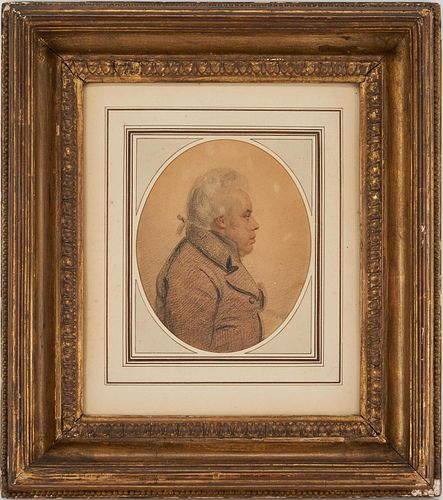Lot 491
Attrib. Charles Balthazar J.F. de Saint-Memin, Portrait of a Gentleman
Estimate: $600 - $800
Sold for
$416
Sold Price includes BP
Bid Increments
| Price | Bid Increment |
|---|---|
| $0 | $10 |
| $100 | $25 |
| $500 | $50 |
| $1,000 | $100 |
| $3,000 | $200 |
| $5,000 | $500 |
| $10,000 | $1,000 |
| $20,000 | $2,000 |
| $50,000 | $5,000 |
| $100,000 | $10,000 |
Attrib. Charles Balthazar Julien Fevret de Saint-Memin (French, 1770-1852) watercolor and charcoal or chalk on paper portrait of a gentleman in side-profile, bust-length view, with white hair and a grey coat. Very faint signature and date lower right appears to read "...Memin 1819" (?). Housed and matted under glass in a molded giltwood frame. Sight: (Oval) 6 3/8" H x 5 1/4" W. Framed: 14 7/8" H x 13 1/4" W. Biography: "Charles Balthazar Julien Fevret de Saint-Memin was a member of the French hereditary nobility, and came to New York City in 1793, at the age of twenty-three as a former military officer exiled by the events of the French Revolution. In New York, Saint-Memin turned to the arts to support himself, his parents, and his sister. With some training in drawing and an aptitude for precision, he taught himself the art of engraving. First, he made a few landscapes and city plans, and then, in 1796 he took up the profession of portraitist. In 1798 he moved the portrait business to Philadelphia and his parents and sister settled in nearby Burlington, New Jersey. In Philadelphia, and later in Washington D. C., Saint-Memin's sitters included senators, congressman, and cabinet members in the federal government. He also attracted local merchants and landowners, French emigres like himself, and members of the United States Army, Navy, and Marines. From 1803 until 1809, Saint-Memin traveled south. His visit to Richmond in 1807-1808 was particularly successful. He made more than 120 portraits in less than a year, a record number for him. His arrival in the summer of 1807 was undoubtedly timed to coincide with the trial of Aaron Burr for treason, which began on August 3; Burr was acquitted in September. During this period, the population of the city almost doubled with witnesses, Burr partisans, and curious spectators. Many of them commissioned the artist to make their portraits, including John Marshall, the presiding judge at the trial. St. Memin and his family returned permanently to France in 1814, after the overthrow of Napoleon and the restoration of the Bourbon monarchy. Several large sets of his engravings were later compiled from hundreds of duplicates that the artist owned. The two largest sets-at the National Portrait Gallery and the Corcoran Gallery of Art-have inscriptions that provide the identifications for many of the portraits. Within the restricted format of the profile portrait, Saint-Memin's drawings and engravings offer an immediacy and realism that is, simultaneously, a stylized and a literal account of many of the residents of Federal America." - Edited essay from The National Portrait Gallery, Ellen G. Miles, Curator, Department of Painting and Sculpture.
The Estate of Raymond White, Nashville, Tennessee.
Toning and scattered spots of light discoloration to background; minute puncture to paper in the lower right quadrant. Some foxing to mat. Wear, abrasions and small losses to frame.
The Estate of Raymond White, Nashville, Tennessee.
Condition
The UPS Store of Bearden 865-584-0081 (press 5), fax 865-584-0094 store2630@theupsstore.com Click to get a quote
The UPS Store of Northshore Knoxville Contact – Eve 865-951-2499 store6461@theupsstore.com
John & Max Express LLC NOTE: large items & white glove delivery services only (driving range limitations may apply) Contact – Dina 865-230-1568 johnmaxexpress@gmail.com












